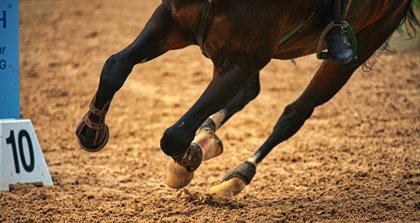
This article has appeared previously with Equestrian Life. To see what's in our latest digial issue, click here.
Consider the surfaces the horse is to train on; they can affect wear and tear.
Ask the vet: Minimising wear and tear
By Dr Maxine Brain
Q: What is the best way to minimise wear and tear on my horse’s legs? - Kelly, Sassafras, Victoria.
A: THERE ARE A number of things we can do to reduce the impact of training on a horse’s legs and thus minimise wear and tear and risk of injury. Many injuries are often the result of lots of low-grade episodes of minor inflammation accumulating over time until they manifest as either an injury or as wear and tear. Managing how a horse is trained is the key.
It is important that a horse is conditioned to the exercise it is required to perform, as sudden increases in exercise intensity or the type of exercise can be detrimental. Muscles, tendons, bones and joints all need to adapt to exercise and if they are not given the opportunity to stretch and strengthen appropriately, inflammation can occur, leading to acceleration of wear and tear. Similarly, even if a horse is accustomed to the level of exercise, it should be given a good warm-up before training. Adequate periods of walking promote good blood supply to the muscles and allow ligaments and joint capsules to loosen. It is also good policy to allow horses to walk to cool off after intense exercise.
Even if a horse is accustomed to the level of exercise, it should be given a good warm-up before riding.
© Stefano Grasso
Good attention to foot balance is essential as a badly balanced foot will have negative effects on the joints of the limb. A small imbalance in the foot can magnify to a bigger imbalance in the joints and ligaments as the foot lands. This results in uneven distribution of weight and forces one side of the leg over the other. This constant low level of unbalanced stress will lead to low-grade inflammation, which, over time becomes “wear and tear”.
Consider the surfaces the horse is to train on. If the arena is not maintained properly and there are inconsistencies in its depth or not enough coverage and the horse is training on too hard a base, then damage and injuries are more likely to occur.
Ice, and even prolonged periods of cold water hosing, can have a beneficial effect on the limbs when used after intense exercise. As heat is one of the major components of inflammation, cooling the limbs before they become too inflamed will help control low-grade issues. Ice is usually of more benefit when treating or managing wear and tear issues as opposed to preventing them. Certainly, if areas of increased heat are noticed in the limbs either following exercise or at rest, then cold therapy should be introduced. The importance of close attention to the horse’s limbs cannot be overstated, so that subtle changes in heat and swelling can be detected long before a major injury occurs.
I should also mention the use of joint supplements, both oral and injectable, which are marketed for use in horses with joint and cartilage issues. Most of these products are forms of, or combinations of, polysulphated glucosamineoglycans (GAGS), chondroitins or hyaluronic acids. Whilst these products in my experience have had very positive responses when used to treat horses with wear and tear issues in their joints, there is no scientific evidence they will prevent a horse from acquiring joint damage if used prophylactically. However, there may be some benefit in using these products as part of an overall management program.
Ice boots are a useful tool.
© Amanda Ross
READ THE LATEST NEWS ARTICLES HERE
https://www.equestrianlife.com.au/articles/Ask-the-vet-Minimising-wear-and-tear

